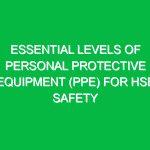Introduction
Lifting safely is critical in various workplaces, particularly in the Health, Safety, and Environment (HSE) sector. Whether you are in construction, warehousing, or healthcare, improper lifting techniques can lead to severe injuries, not only affecting individuals but also impacting overall workplace productivity and morale. By adopting Best Practices for lifting safely, you can significantly reduce the risk of injury, enhance operational efficiency, and foster a culture of Safety. In this article, we will delve into essential tips for lifting safely, explore potential Hazards, and highlight the importance of proper lifting techniques within the HSE framework.
Understanding Lifting Safely in the HSE Context
Lifting safely refers to the techniques and practices that individuals should employ to minimize the risk of injury while handling heavy objects. In the HSE context, it encompasses a range of guidelines, training protocols, and regulatory Standards aimed at ensuring that lifting tasks are performed without jeopardizing health and Safety. The importance of lifting safely cannot be overstated—it not only protects workers but also contributes to a more efficient and productive work environment.
Key Components of Lifting Safely
1. Assessing the Load
Before attempting to lift any object, it is vital to assess its weight and dimensions. Understanding what you are about to lift allows you to determine whether you can handle it alone or if you need assistance or equipment. Here are some considerations:
- Weight: If the load is too heavy, call for assistance or use lifting aids.
- Shape: Irregularly shaped objects can be difficult to grip and balance.
- Obstructions: Check the lifting area for obstacles that could lead to tripping or falling.
2. Proper Lifting Techniques
Using proper lifting techniques is crucial to lifting safely. Here are steps to follow:
- Stand close to the load: Position yourself so that you minimize the distance between your body and the load.
- Feet positioning: Place your feet shoulder-width apart for stability.
- Bend your knees: Use your legs to lift rather than your back. Squat down and keep your back straight.
- Grip: Securely grasp the object, ensuring you have a firm hold before lifting.
- Lift with your legs: Stand up by straightening your legs, not your back. Avoid twisting your body while lifting.
3. Team Lifting
When dealing with particularly heavy or awkward items, team lifting is often the safest solution. Effective communication between team members is essential. Here are some guidelines:
- Plan the lift: Discuss how you will lift and move the object before attempting it.
- Count to three: Lift simultaneously on a count of three to ensure coordinated effort.
- Designate a leader: Choose one person to guide the lift and movement.
4. Use of Equipment
Lifting aids such as dollies, forklifts, or hoists can significantly reduce the risk of injury. Familiarize yourself with the proper use of such equipment and adhere to the following:
- Training: Ensure you have received Training on the equipment you are using.
- Inspection: Regularly inspect lifting equipment for any signs of wear or damage.
- Load limits: Never exceed the specified weight limits of lifting equipment.
Identifying Potential Hazards
Understanding potential hazards associated with lifting is an essential part of lifting safely. Here are common risks to consider:
- Muscle Strains: The most common injury from improper lifting is muscle strain, particularly in the back and shoulders.
- Slips and Falls: Wet or uneven surfaces can lead to slips while lifting, increasing the risk of injury.
- Drop Hazards: Failing to secure a load can result in dropping it, posing a risk to the lifter and nearby individuals.
Best Practices for Lifting Safely
To consistently lift safely, consider the following Best Practices:
1. Training and Education
Regular training sessions on lifting techniques should be mandatory for all employees, especially in industries with high lifting demands. Training not only educates workers about the physical techniques but also raises awareness of potential hazards.
2. Encouraging a Culture of Safety
Fostering an environment where safety is prioritized encourages employees to be mindful of lifting practices. Management should lead by example, demonstrating safe lifting techniques and encouraging open communication about safety concerns.
3. Regular Breaks and Stretching
Taking regular breaks and incorporating stretching exercises can help prevent fatigue and muscle strain. Encourage employees to stretch before and after lifting tasks to keep their muscles flexible.
Regulations and Standards Governing Lifting Safely
Several Regulations and standards guide lifting safely within the HSE context. Familiarity with these regulations can help organizations maintain compliance and protect their workers. Some key regulations include:
- OSHA (Occupational Safety and Health Administration): osha sets forth guidelines for safe lifting practices, requiring employers to provide adequate training and resources.
- Manual Handling Operations Regulations 1992: This UK regulation emphasizes the importance of risk assessment in Manual Handling tasks.
- ISO 45001: This international standard outlines Occupational Health and safety management systems, including guidelines for Manual Handling.
Understanding these regulations not only helps organizations avoid penalties but also promotes a culture of safety that prioritizes worker health.
Conclusion
Lifting safely is not just a personal responsibility; it is a collective commitment within any workplace environment. By understanding the principles of safe lifting, recognizing risks, and adhering to best practices, individuals can unlock their potential to work injury-free. Embracing a culture of safety, investing in training, and complying with relevant regulations will ensure that lifting tasks are conducted without compromising health and safety. Remember, every lift counts—ensure you lift safely today for a healthier tomorrow.


